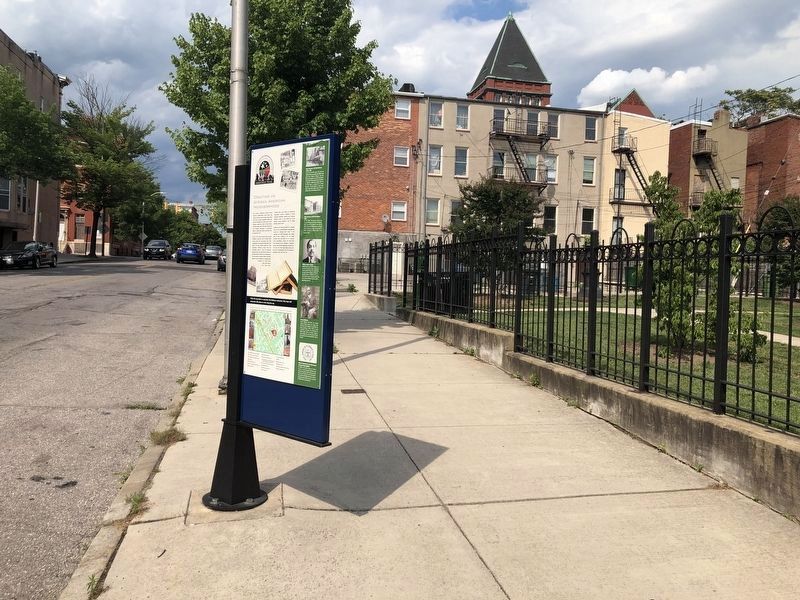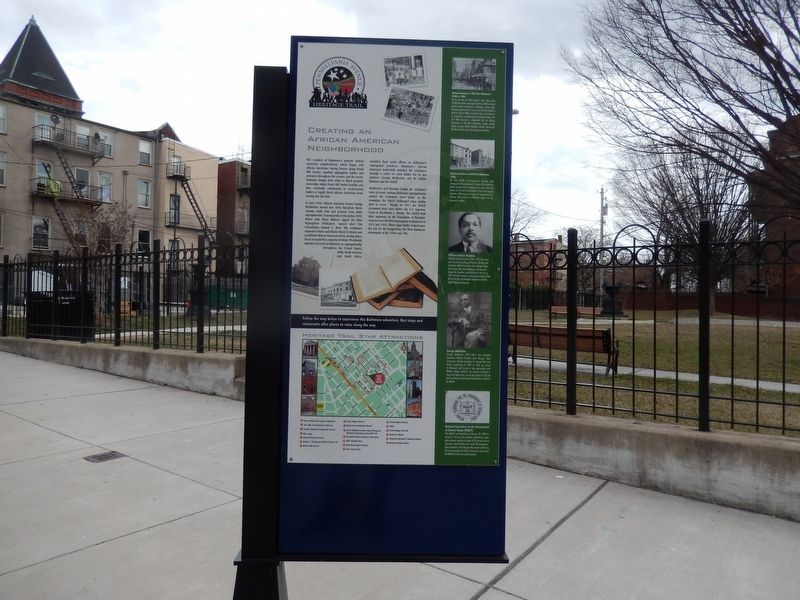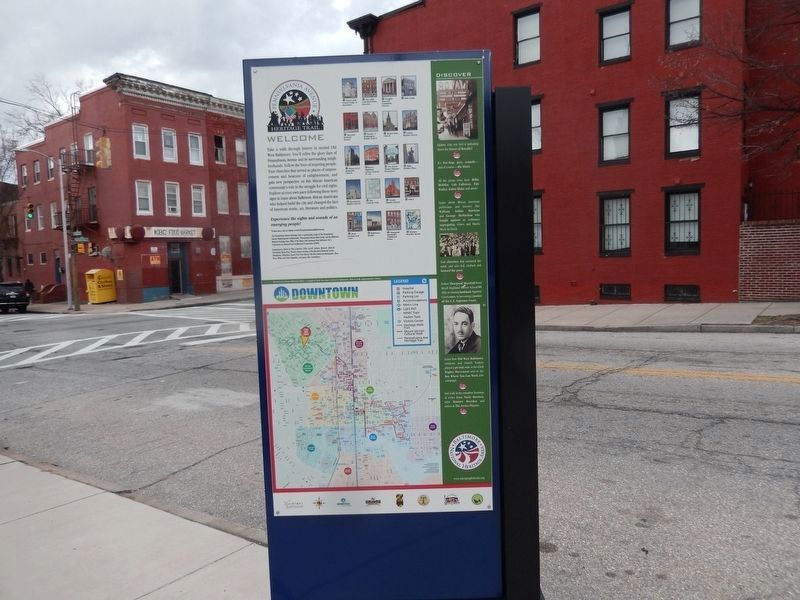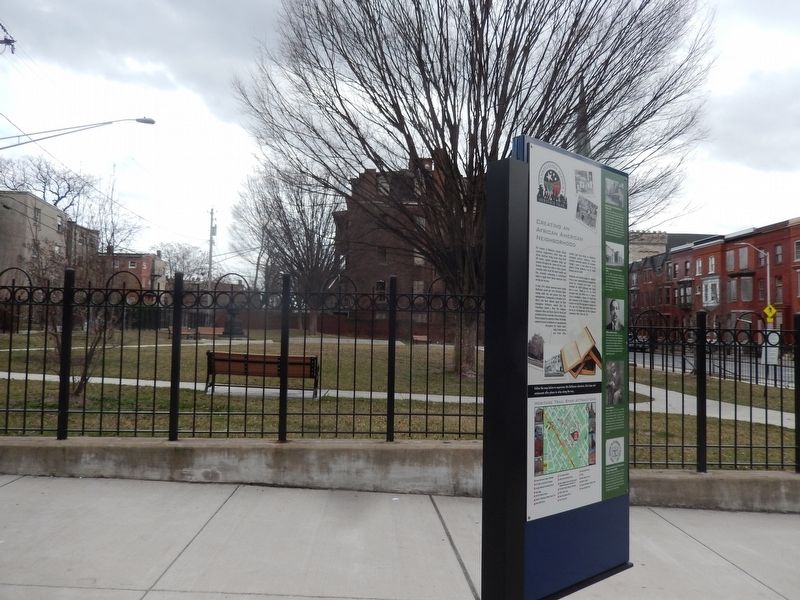Upton in Baltimore, Maryland — The American Northeast (Mid-Atlantic)
Creating an African American Neighborhood
Pennsylvania Avenue Heritage Trail
The creation of Baltimore’s premier African American neighborhood, which began with African Americans buying houses along Druid Hill Avenue, sparked segregation battles and practices throughout the country and the world. Dramatic change from white to black property ownership within Druid Hill fueled hostility and fear, eventually culminating in orchestrated battles to legally block African Americans from moving into the area.
In June 1910, African American lawyer George McMechen moved into 1834 McCulloh Street, causing small riots and protests from white segregationists. Consequently, in December 1910, Mayor John Barry Mahool signed the West Segregation Ordinance, named after City Councilman Samuel L. West. The ordinance separated whites and blacks block by block, and prohibited African Americans from moving into a block occupied by a majority of whites. Worldwide attention focused on Baltimore as segregationists throughout the United States, India, South America and South Africa modeled their racist efforts on Baltimore’s segregation practices. Baltimore’s African American leadership attacked the ordinance through a series of court battles led by law partners George McMechen and W. Ashbie Hawkins and the NAACP. McMechen and Hawkins fought the ordinance twice in court, making Baltimore segregationists amend the ordinance three times. In the meantime, the NAACP challenged many similar laws in court. Finally, in 1917, the NAACP presented their case before the U.S. Supreme Court in Buchanan v. Warley. The NAACP built their argument on the foundation of Hawkins’ victory over the West Segregation Ordinances in 1911 and 1913. These legal battles helped pave the way for the burgeoning Old West Baltimore community of the 1920s and ‘30s.
(Inscription under the images on the right)
African Americans in Old West Baltimore 1860s to 1900
By the time the Civil War began in 1861, there were 26,000 free blacks and approximately 2,000 enslaved people living in Baltimore. Although a slave state, Maryland accounted for one of every 100 free blacks in America. By the 1900, nine blocks along “the bottom” (a colored race neighborhood developed before the Civil War) became a residential hub for African Americans in Old West Baltimore. Streets named Argyle, George, Myrtle, Dolphin, Harlem, Brunt and Division made up the developing community.
African Americans in Old West Baltimore: 1930s
By the 1930s, Pennsylvania Avenue had emerged as the commercial center of Baltimore’s black community. It extended from more than 50 blocks to the north of Dolphin Street and Argyle Avenue, offering an avenue of opportunity to African Americans at different rungs on the economic
ladder.
William Ashbie Hawkins
William Ashbie Hawkins (1862-1941) was born and raised in Lynchburg, Virginia. He attended Centenary Biblical Institute (now Morgan State University), Maryland University and Harvard University. Hawkins was admitted to the bar in 1897. Hawkins became a founding member of the W.E.B. DuBois-led Niagara movement and the NAACP Baltimore Branch.
George McMechen
George McMechen (1871-1961) also attended Centenary Biblical Institute (now Morgan State University). Shortly thereafter, he entered Yale Law School, graduating in 1899. In 1904, he moved to Baltimore and formed a law partnership with William Ashbie Hawkins. He became involved in many civil rights cases, ran for city council in 1915 (he lost) and became the Grand Exalted Ruler of Elks of the World.
National Association for the Advancement of Colored People (NAACP)
The NAACP was founded on February 12, 1909. Its mission is ”to ensure the political, educational, social, and economic equality of rights of all persons and to eliminate racial hatred and racial discrimination.” Many members of the Niagara Movement, which was formed exclusively by African Americans, also joined the NAACP which was racially diverse.
Reverse Side of the Marker
Welcome
Take a walk through history in storied Old

Photographed By Devry Becker Jones (CC0), June 26, 2020
3. Creating an African American Neighborhood Marker
(Inscriptions under the images on the right)
1.Prince Hall Grand Lodge of Maryland
2.The Lillie Carroll Jackson Museum
3.Douglas Memorial Community Church
4.Elks Lodge
5.Morriah Keyhole Houses
6.Booker T. Washington Middle School
7.Bethel AME Church
8.Union Baptist Church
9.Sharp Street Methodist Church
10.Henry Highland Garnet School/PS 103
11.The Royal Theatre Marquee Monument
12.Billie Holiday Plaza
13.Macedonia Baptist Church
14.The Comedy Club
15.Trinity Baptist Church
16.YMCA
17.Ideal Savings and Loan
18.Baltimore Masjid
19.Thurgood Marshall’s Childhood Home
20.Romare Bearden Mural.
Discover
(Inscriptions under the images)
*Listen, Can you feel it pulsating down the Street of Royalty?
*It’s bee-bop, jazz, comedy—and of course—the blues.
*All the greats were here. Billie Holiday, Cab Calloway, Fats Waller, Eubie Blake and more!
*Learn about African American politicians and lawyers like William Ashbie Hawkins and George McMechan who fought against an ordinance segregating whites and blacks block by block.
*Visit churches that nurtured the soul, and also fed, clothed and housed the poor
. *Follow Thurgood Marshall from Henry Highland Garnet School/PS 103, to winning landmark Supreme Court cases, to becoming a justice of the U.S. Supreme Court.
*Learn how Old West Baltimore residents and church leaders played a pivotal role in the Civil Rights Movement and in the Buy Where You Can Work jobs campaign.
*And walk in the creative footsteps of writer Zora Neale Hurston, artist Romare Bearden and actors at the Arena Players.
Topics and series. This historical marker is listed in these topic lists: African Americans • Civil Rights • Industry & Commerce • Settlements & Settlers. In addition, it is included in the Historically Black Colleges and Universities series list. A significant historical date for this entry is February 12, 1909.
Location. 39° 18.175′ N, 76° 37.757′ W. Marker is in Baltimore, Maryland. It is in Upton. Marker is at the intersection of West Lafayette Avenue and Druid Hill Avenue on West Lafayette Avenue. Touch for map. Marker is in this post office area: Baltimore MD 21217, United States of America. Touch for directions.
Other nearby markers. At least 8 other markers are within walking distance of this marker. Henry Highland Garnet Park (a few steps from this marker); Rev. Dr. Vernon Nathaniel Dodson Memorial (within shouting distance of this marker); Bethel A.M.E. Church (about 400 feet away, measured in a direct line); Henry Highland Garnett School (about 500 feet away); Union Baptist Church (about 500 feet away); African American Politicians (about 500 feet away); William Stewart Halsted, M.D. (about 600 feet away); Courting Justice (about 700 feet away). Touch for a list and map of all markers in Baltimore.
Credits. This page was last revised on March 16, 2021. It was originally submitted on March 4, 2017, by Don Morfe of Baltimore, Maryland. This page has been viewed 575 times since then and 40 times this year. Last updated on March 16, 2021, by Carl Gordon Moore Jr. of North East, Maryland. Photos: 1, 2. submitted on March 4, 2017, by Don Morfe of Baltimore, Maryland. 3. submitted on June 26, 2020, by Devry Becker Jones of Washington, District of Columbia. 4. submitted on March 4, 2017, by Don Morfe of Baltimore, Maryland. • Devry Becker Jones was the editor who published this page.


